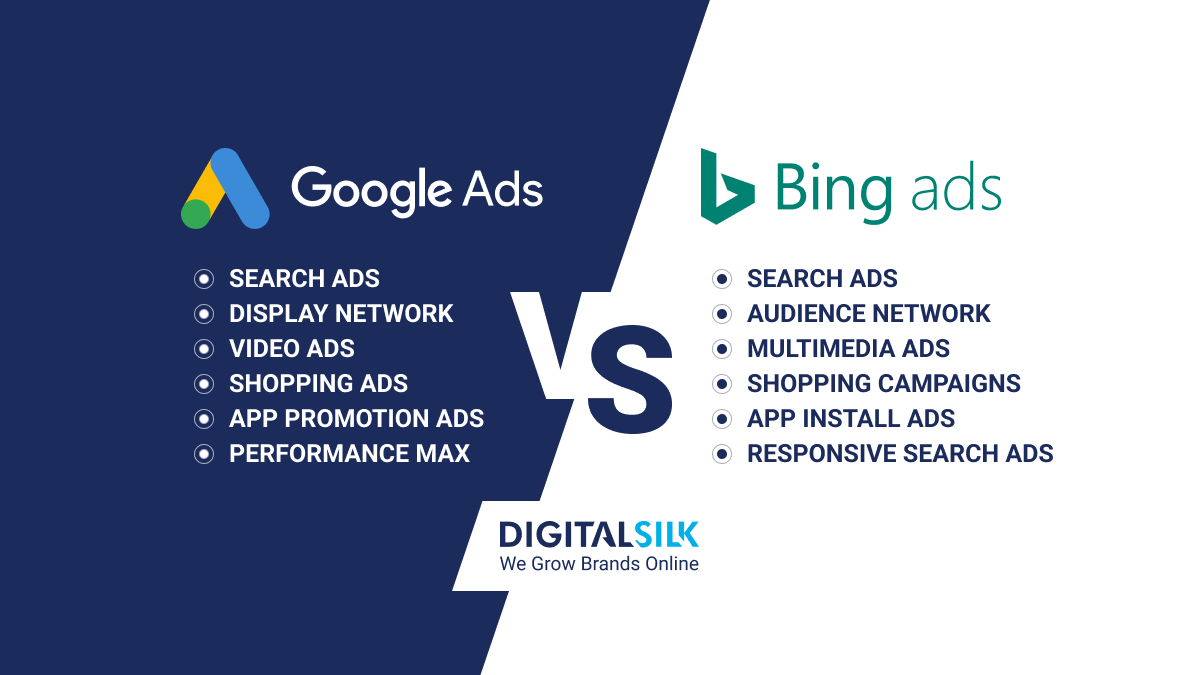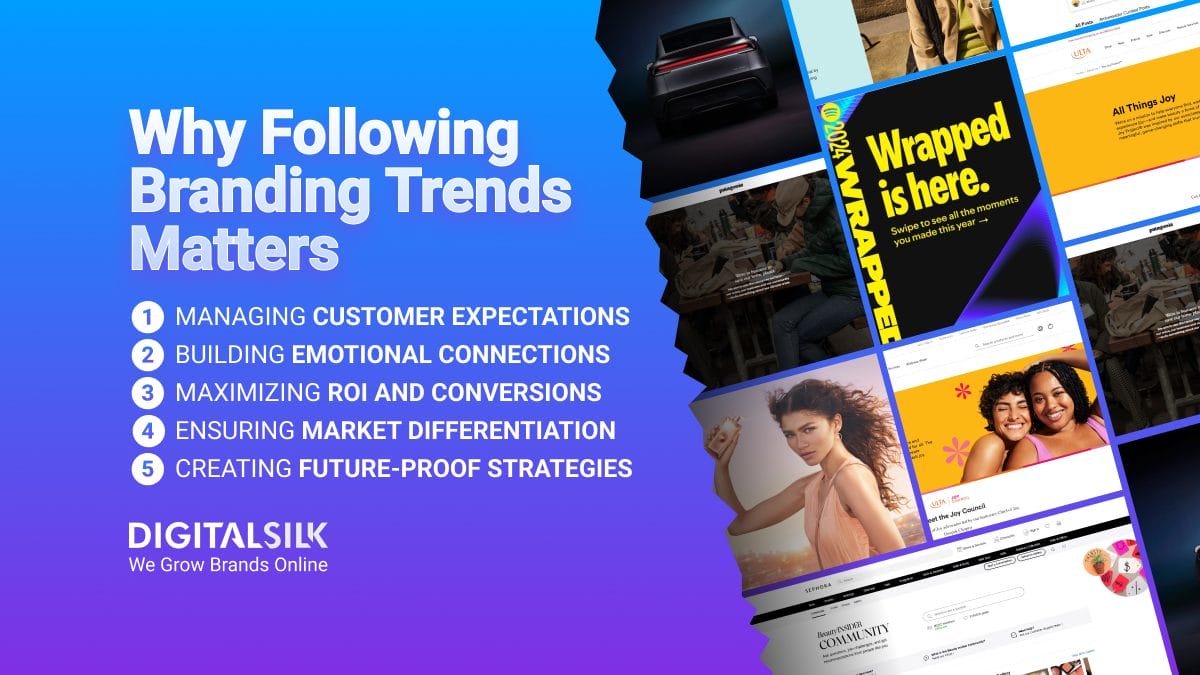When Steve Jobs rejoined Apple in 1996, the company was weeks away from declaring bankruptcy.
Fast forward to 2023 and Apple’s brand value is a whopping $297.5 billion, the second highest for a tech company in the world.
So how did Steve Jobs reverse (or rather save) the company’s fate on top of Microsoft’s $150 million investment?
With a new digital strategy, focused on simplicity.
If you’re looking for a reason why your business should implement a digital strategy — maybe even one as life-changing as Apple’s — we’ve got you covered.
In this article, we’ll explain the benefits of a digital strategy, share top examples from successful brands and detail our own digital strategy services at Digital Silk.
Work with our digital marketing experts. Request a quote
What Is A Digital Strategy?
A digital strategy is an all-encompassing guide that defines the goal for your digital project and outlines the most effective pathways to achieve them.
A digital strategy outlines your target audience, competitive landscape, goals, key performance indicators and your existing user journey.
This strategy provides a consistent direction and vision for your project, while ensuring everyone involved is on the same page, using the defined pathways to work towards achieving the same goals and vision.
Digital Strategy vs. Digital Marketing Strategy
Now that you know what a digital strategy is, let’s define the other terms that are often used interchangeably, albeit incorrectly.
A digital strategy is a broad term that focuses on using technology in general to improve your brand’s online presence.
In contrast, a digital marketing strategy is a roadmap of your digital marketing activities.
A digital marketing strategy allows you to choose and manage the channels and platforms you will utilize to reach your audience, so you can plan marketing campaigns that are aligned with your goals.
Digital Strategy vs. Digital Transformation
A digital transformation is the organizational, operational or cultural change your business goes through by integrating digital technologies and processes — like the ones you outline in your digital strategy.
Areas of your business that might undergo digital transformation include:
- Customer engagement
- Customer experience
- Logistics and operations
- Product or service
- Business model
Why Should Your Brand Invest In A Digital Strategy?
Whether you own an established brand or a startup company, a digital strategy can help you define your goals and outline specific methods to achieve them.
Treat your digital strategy as your guiding light to improving the performance of your website, marketing campaigns, paid advertisements and other aspects of your online presence.
Ultimately, the reason to invest in a digital strategy varies from one business to the next.
For example, if you own a small- to mid-size enterprise and you’re competing with larger corporations, a thorough digital strategy can help you increase your online presence and position your brand to better compete.
The same can be said for startups looking to improve visibility and build a positive brand reputation.
A digital strategy can help you understand new trends and speak to the needs of consumers – whether it’s building a new brand identity or developing messaging that connects with your target audience.
If you’re not sure where to start, you can hire a professional web design agency to create a digital strategy for you.
At Digital Silk, our experts:
- Measure the efficiency of your digital channels
- Provide expert recommendations on how you can maximize your marketing campaigns and strategic communications
- Initiate and lead your digital projects
- Measure success using set key performance indicators (KPIs)
- Consistently assess and adjust as needed
Speak with our experts. Set Up A Consultation
What Are The Key Elements Of A Digital Strategy?
From SMART goals to your launch plan, here are the six key elements of a digital strategy.
1. SMART Goals
SMART goals refer to specific, measurable, achievable, results-focused and timebound results that you want your digital strategy to achieve.
SMART goals allow you to stay on track when defining goals during brainstorming sessions.
Your goals may include:
- Educate potential clients or customers about your offering
- Increase brand visibility
- Improve the performance of your existing website
- Maintain customer engagement through social media, blog posts and marketing campaigns
- Position your brand as one of the top players in the industry
2. Research
Once you have your SMART goals in place, it’s time to perform competitor research.
This should include industry research, market research and competitor analysis.
Conduct industry research to determine the latest trends and innovations in your industry.
Let’s say you’re in the tech industry.
Which products are going viral or are failing? Can you implement virtual and augmented reality into your website to help influence the purchasing decision for your customers?
Next, perform your market research. Market research provides insights into your target audience’s spending behavior, including who they are and what they like.
Finally, a competitor analysis allows you to get a glimpse into your competitors’ strengths (what they do well) and weaknesses (areas for improvement) to distinguish your brand’s potential threats and opportunities.
3. Target Audience
Your target audience is made up of consumers who are most likely interested in your brand’s products or services.
You can determine your target audience by:
- Performing market research into purchasing habits, demographics (age and gender) and psychographics (hobbies and lifestyle)
- Understanding pain points or how your product or services can solve challenges
- Identifying your existing customers
- Creating user personas or semi-fictional representations of your ideal consumers
4. User Journeys
The user journey is how your target audience will navigate through a conversion funnel, or the stages where your prospects move from the moment they become exposed to your products or services to when they decide to convert or purchase.
User journeys can occur in multichannel environments, such as your website, a social media channel and an ad, or a single-channel environment, such as your website.
Here is an example of a user journey in a multichannel environment:
- A prospect sees your brand promoted on a pay-per-click (PPC) ad
- They then search Google for your brand’s social proof, like customer reviews and testimonials
- When they like what they see, they’ll go to your contact page and get in touch to inquire about your offerings
To create a user journey map or a visual representation of a customer’s experience, consider these steps:
- Create user personas: Typically, you’ll need a different user journey map for each user persona since not all of your customers will have the same needs and pain points.
- Define pain points and expectations: Now that you have a better idea of who your target audience is, think of what they want and the possible challenges they’ll face. How will your offerings solve their problems? What problems may they face once they start their user journey? Is your nav bar intuitive or will your users think of how they can navigate your site?
- Perform quality assurance on your user journey: If you focused your user journey on your website, validate your user journey map by navigating through the user journey yourself. Are your contact details visible and sticky so your user won’t lose sight of it wherever they are on your homepage? Are your CTA buttons specific and give a clear idea of what will happen when your user clicks on them?
5. Key Performance Indicators (KPIs)
Key Performance Indicators (KPIs) are quantitative indicators that measure the success of your digital project.
KPIs are important since they keep your objectives at the forefront of your decision-making and allow you to measure how well your business is doing working towards your digital project goals.
KPIs may include, but aren’t limited to:
- Website engagement
- Traffic
- Qualified leads per month
- Website conversion rate
- Customer acquisition cost
- Social media engagement rate
Setting up specific KPIs and monitoring the numbers can help you evaluate your campaigns, search engine rankings, traffic, and more, so you can identify what’s working and what needs to be tweaked for improvement. Explore this case study and see how web design and SEO optimization helped one of our clients increase organic search by 43%, session duration by 117%, and customers stay on page by 60% more.
6. Launch Plan
A digital strategy allows you to outline your launch plan or how your digital project will be executed.
Digital projects can range from launching a redesigned website to implementing a series of influencer marketing campaigns.
A launch plan includes a project timeline and an overview of your project’s deliverables with their deadlines, to ensure your deliverables are completed before pushing your project live.
Our experts can help. Schedule A Consultation
3 Examples Of Successful Digital Strategies
The best digital strategy is the kind that evolves and keeps up with consumer trends and demands.
Here are some of the most successful digital strategies from three top brands.
1. The New York Times

In 1995, The New York Times, one of the top global newspapers, established in 1851, used technology to launch its online edition and expand its circulation.
In 2005, The New York Times introduced a subscription-based service where users paid $49.95/per year to read their published content such as Op-Ed, news columnists, online archives and more.
While most of their website’s content remained free, The NYT decided to make some of their content exclusive to paid users to capitalize their site’s growing popularity.
In 2006, The NYT introduced an electronic version called The Times Reader, which allowed subscribers to download their newspaper’s printed edition.
In 2011, they implemented a paywall and subscription model, allowing readers to access 20 online articles per month for free, but having to pay an additional $15/month if they wanted to read more.
As the news became increasingly popular to digest online content, the company adapted at every turn.
This digital strategy brought remarkable results: in 2016, the newspaper made close to $500 million in purely digital revenue.
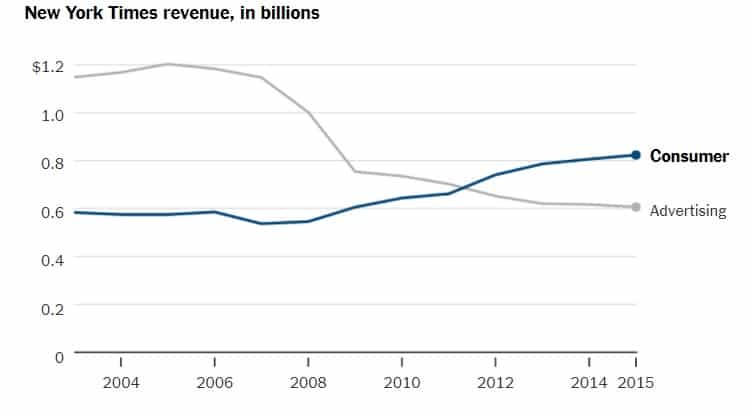
Today, The NYT has an even stronger digital strategy. The newspaper uses full-page imagery and colorful presentations to share stories, from news to sports, politics and more.
The result?
Steady climbing revenues that hit $2.31 billion in 2022.

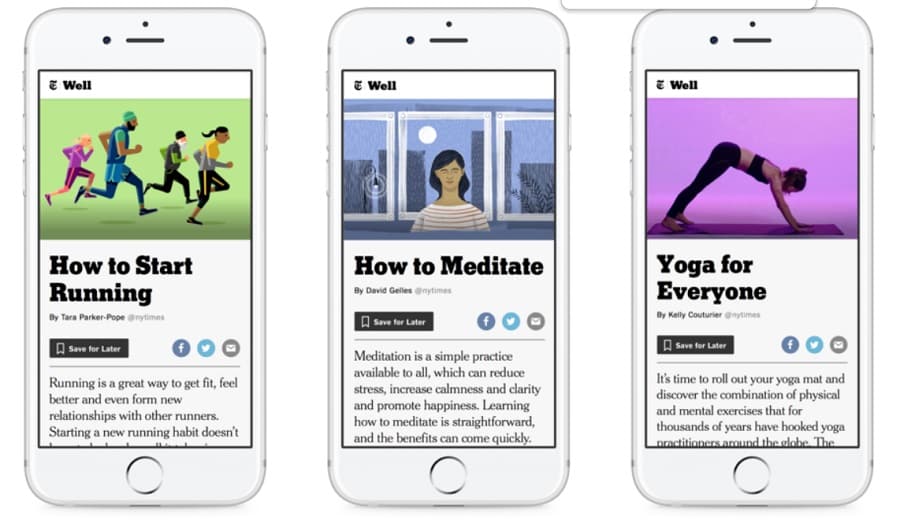
The lesson: The New York Times’ digital strategy cemented their market position and increased revenue by planning ahead, meeting tech trends and adjusting to evolving consumer behavior.
2. Adobe

In 2013, Adobe moved from purely physical software to Creative Cloud, to achieve a revenue of $17.6 billion in fiscal 2022.
You can visualize the moment of change in the graph below:
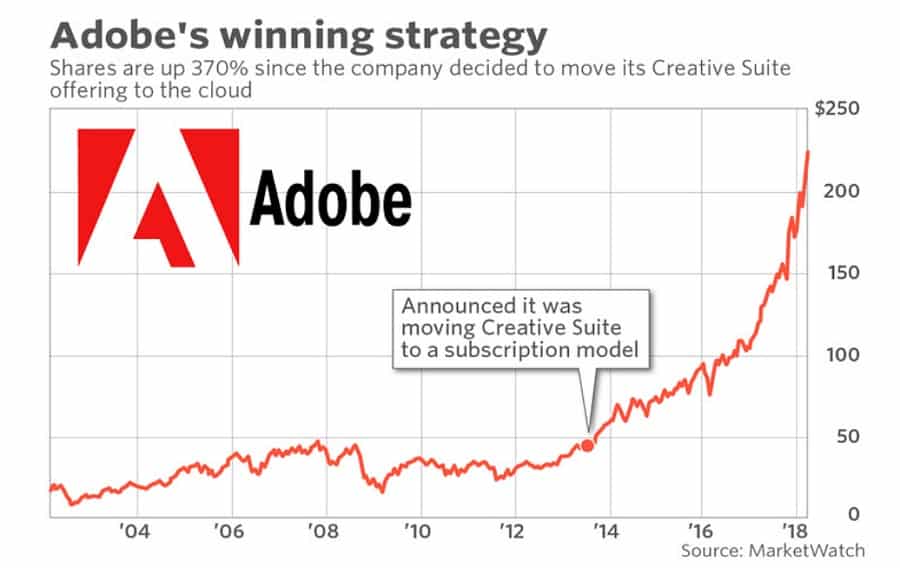
This revolutionary change increased software control, and decreased piracy while answering the growing demands of their consumers.
In 2018, Adobe acquired Magento Commerce, an eCommerce service provider followed by the purchase of Marketo, a marketing automation software company.
Adobe never stopped developing digitally.
In 2021, they announced they were adding payment services to their eCommerce platform.
As Alvaro Del Pozo, VP of international marketing at Adobe, explains:
“Trends and technology that were years away from serious consideration are now at the top of the agenda. Additionally, businesses are all grappling with the same challenges: remote working, new all-digital customers with different buying behaviors, and, added to that, their employees’ and their customers’ well-being.”
The lesson: By understanding the needs and expectations of their users, Adobe offered innovative solutions, deserving their place among the leading digital businesses.
3. Alibaba

Challenged by the growing number of customers and an uptick in orders, Chinese eCommerce titan Alibaba used artificial intelligence (think automated mobile robots) to build a smart warehouse with automated packaging and shipping.
Check out the video they launched to showcase their innovation:
Today, their digital strategy encompasses everything from chatbots (Alime is Alibaba’s chatbot) to smart product searches and recommendations to optimize the purchasing process and create a unique user journey.
Take a look at the chart below to see the impact this has had on their numbers of buyers since 2017:
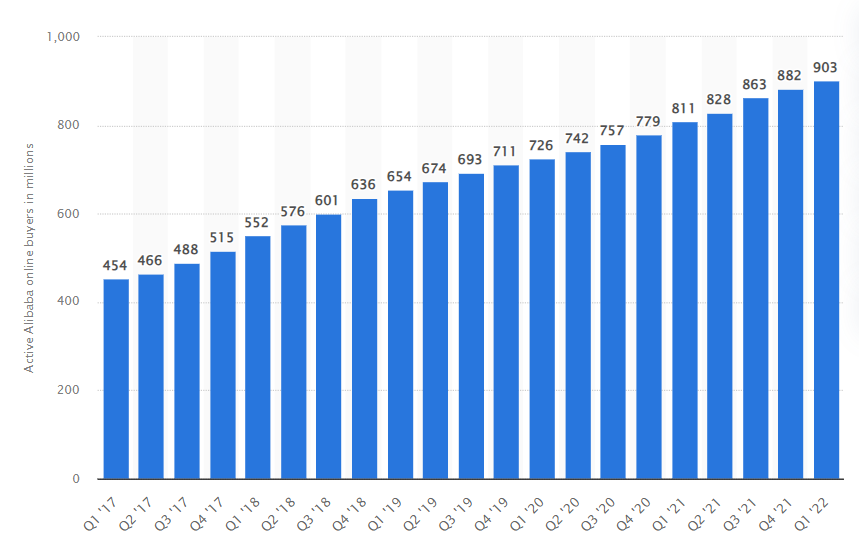
The lesson: Defining your specific business goals and acting from a user-centered perspective provokes interest, provides a competitive edge and does not go unnoticed by consumers.
Let’s discuss your digital strategy! Schedule A Consultation
Digital Strategy Services At Digital Silk
At Digital Silk, we create all-encompassing digital strategies to build and strengthen your online presence.
Our experts use data-backed insights into your industry, target audience and competitors to create a unique, actionable strategy to grow your brand and reach your specific goals.
At Digital Silk, we offer a wide range of digital marketing services including:
- PPC
- SEO
- Content marketing
- Social media
- Email marketing
Key Takeaways On A Digital Strategy
A digital strategy plays a key role in improving your brand’s processes, may it be reimagining your current process or presenting your products through a new marketing strategy.
It outlines the direction your brand should take to gain a competitive advantage and ultimately, to thrive in the digital landscape.
At Digital Silk, we offer:
- Custom web design services
- Custom web development services
- Digital and branding services
- Digital marketing services
Whether you’re looking to build a custom web design, software or online content to increase your online presence, our experts will exceed your expectations on every project. Get in touch online, call us at (800) 206-9413 or fill in the request a quote form below to start your journey.
"*" indicates required fields




